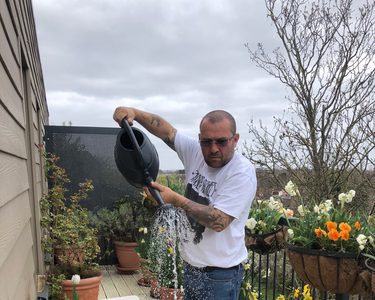Chris Collins on…hardening off your plants

May arrives and the trees are breaking leaf on the New River canal in my little part of North London. The vibrancy of this green flush never fails to disappoint and this year our trees are abundant in flowers, an often-overlooked quality of our deciduous trees.
With the days getting longer, my one-time seedlings are now becoming small juvenile plants and as the temperature steadily rises it’s time for me to prepare them for their full-time outdoor life. It’s time to ‘harden off’ tender plants such as tomato and tagete, which I’ve so lovingly raised from seed in propagators and the comfort of my home.
Hardening off is a well-used word in gardening, especially at this point of the year, and in a nutshell, it’s the process of acclimatising young plants in preparation for their final planting spot. Professional gardeners will be moving their charges from greenhouses to cold frames, protecting them at night from late frosts and cold winds, whilst exposing them to the sunshine and lower, fresher temperatures throughout the day.
In my own set up, I will handball my plants out onto the balcony for the day before returning then indoors for protection overnight. On the allotment, small cold frames and mini unheated greenhouses will do the same job as I prepare my plants for the arrival of the summer and warmer days.
Why harden off young plants?
To some hardening off may seem like a lot of work, but this method is entirely beneficial for our plants. If we want them to perform well throughout the growing season, a plant that has been through the ‘hardening off’ process is less vulnerable. Its leaf cells have been strengthened by the gradual change in temperatures, and they’re also less likely to sustain heavy damage from pests as their cell structures have had time to toughen up.
A plant that has had time to acclimatise will be stronger, sturdier, and far more productive than one that has been plunged into its final position without any preparation. Hard work and effort now by the gardener means greater rewards further down the line.
My final tip is to not take any chances with your tender plants until late May. When it comes to planting out into their final positions, cold winds and air frosts know as ‘radiation frosts’ can still appear in May. This is particularly important the further north you garden. A late cold wind might not kill your plants but will definitely check their growth and weeks of vital growing time can be lost.
Eyes on the prize my fellow gardeners, patience now means prizes to come!